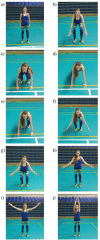International Standards for the 3-Minute Burpee Test: High- Intensity Motor Performance
- PMID: 31666896
- PMCID: PMC6815084
- DOI: 10.2478/hukin-2019-0021
International Standards for the 3-Minute Burpee Test: High- Intensity Motor Performance
Abstract
The aim of this study was to develop international standards for evaluating strength endurance with the use of the 3-Minute Burpee Test. The results of 3862 women (Poland - 2502, Great Britain - 500, Hungary - 412, Serbia - 448) and 5971 men (Poland - 4517, Great Britain - 500, Hungary - 451, Serbia - 503) aged 18-25 (mean age of 20.36 ± 0.94 and 20.05 ± 1.25 y, respectively) were collated between 2004 and 2018. The students' strength endurance was evaluated in the 3-Minute Burpee Test. The results were expressed on a uniform scale with the 3-sigma rule which was used to develop the T-score scale for the 3-Minute Burpee Test. Men completed 56.69 cycles/3 min and women - 48.84/3 min on average. The best male participant completed 82 burpees, and the best female participant - 73 burpees. The majority of male and female participants (66.71% and 68.18%, respectively) were characterized by average strength endurance in the 3-Minute Burpee Test (range of scores: 47-66 and 37-60 cycles/3 min, respectively). Very good strength endurance (76-85 and 72-83 cycles/3 min, respectively) was noted in the smallest percentage of male and female participants (0.52% and 0.26%, respectively). Similar studies should be carried out in other countries and in different age groups to develop objective international classification standards for variously-aged individuals.
Keywords: 3‐MBT; extreme effort; norms; strength endurance.
© 2019 Robert Podstawski, Piotr Markowski, Cain C. T. Clark, Dariusz Choszcz, Ferenc Ihász, Stanimir Stojiljković, Piotr Gronek, published by Sciendo.
Figures
References
-
- Alonso-Fernandez D, Lima-Correra F, Gutierrez-Sánchez Á, Abadia-Garcia de Vicuńa O. Effects of a high- intensity interval training protocol based on functional exercises on performance and body composition in handball female players. JHSE. 2017;12(4):1186–1198. doi: 10.14198/jhse.2017.124.05. - DOI
-
- Astrand PO, Rodahl K, Dahl HA, Strömme SB. Textbook of Work Physiology. Physiological Bases of Exercise Fourth Edition Ill, Human Kinetics; 2003.
-
- Choszcz D, Podstawski R, Konopka D. Modeling of anthropometric determinants of rowing ergometer performance on a distance of 500 meters for physically inactive males. J Phys Ed Sport. 2012;12(3):274–283.
-
- Di Pietro L, Dziura J, Yeekel CW, Neufer PD. Exercise and improved insulin sensitivity in older women: evidence of the enduring benefits of higher intensity training. J Appl Physiol. 2006;100(1):142–9. - PubMed
LinkOut - more resources
Full Text Sources

